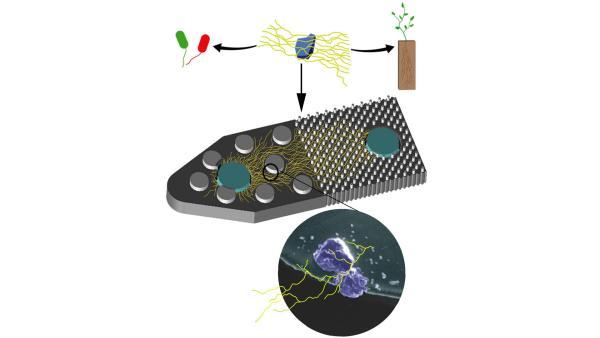Observing Fungi Transport Minerals for the First Time
Using a specialized micromodel, scientists are shedding light onto how soil fungi enable plants to access mineral nutrients.

Scientists demonstrated a first-of-its-kind platform, enabling them to visualize where and exactly how mineral weathering mechanisms occur. (Photo courtesy of Adobe)
The Science
Scientists had evidence that soil fungi could bridge the gap between inorganic nutrients and other microorganisms and plants that need them. Exactly how fungi wore down or weathered soil nutrients at the microscopic scale and what complex interactions occurred during this process were not possible to spot. So, scientists built their own bridge across this knowledge gap and demonstrated a first-of-its-kind platform that enabled them to visualize where and exactly how mineral weathering mechanisms occur. Their work provides an unprecedented look into nutrient transport in soils.

The Impact
Fungi form the foundation of the community of organisms living in soil. Through a network of filaments, they grab onto and transport vital nutrients that help their neighbors survive and thrive. Their contributions to the extraction and transport of potassium, iron, manganese, and calcium are particularly important in nutrient-poor soils. The new mineral-doped micromodel offers scientists a way to peer deep into the inner workings of these soil fungi, building a more complete understanding of how they weather and transport nutrients. That understanding will help scientists keep soils and plants for biofuels and agriculture healthy as water availability and nutrient levels change with the environment.
Summary
A multi-institutional team of scientists developed a first-of-its kind micromodel platform that simulates the chemical and physical complexity of weathered soil. Made from a type of silicone, the platform features an evenly spaced matrix of tiny pillars that mimics pore spacing found in soil. Scientists covered those pillars with minerals and soil fungi. They then used advanced instrumentation—such as mass spectrometry imaging and X-ray fluorescence available from EMSL, the Environmental Molecular Sciences Laboratory, a Department of Energy (DOE) Office of Science user facility, and the Stanford Synchrotron Radiation Lightsource—to observe how the fungi weathered the minerals. They discovered that the fungi secreted molecules which reacted with the minerals, releasing potassium. The nutrient then moved through the filaments of the fungi and out into the surrounding environment. The study thus demonstrated the efficacy of the platform for visualizing activities at the microbial scale and should prove particularly useful for understanding how fungi function under nutrient and water stresses.
Contacts
Arunima Bhattacharjee, EMSL, arunimab@pnnl.gov
Christopher Anderton, EMSL, christopher.anderton@pnnl.gov
Funding
This research was supported by the DOE Office of Science, Biological and Environmental Research program. A portion of the work was conducted using capabilities at EMSL, the Environmental Molecular Sciences Laboratory, a DOE Office of Science user facility, as well as the Stanford Synchrotron Radiation Lightsource.
Publication
A. Bhattacharjee, et al., “A mineral-doped micromodel platform demonstrates fungal bridging of carbon hot spots and hyphal transport of mineral-derived nutrients.” mSystems 7 (2022). [DOI: 10.1123/msystems.00913-22]

